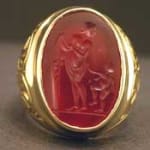18 Karat Gold Ring Featuring a Classical Revival Seal of the Goddess Aphrodite and Eros, 1700 CE - 1800 CE
Gem-Gold
FJ.6487
Further images
The art of glyptics, or carving on colored precious stones, is probably one of the oldest known to humanity. Intaglios, gems with an incised design, were made as early as...
The art of glyptics, or carving on colored precious stones, is probably one of the oldest known to humanity. Intaglios, gems with an incised design, were made as early as the fourth and third millennia BC in Mesopotamia and Aegean Islands. they display a virtuosity of execution that suggests an old and stable tradition rooted in the earliest centuries. The tools required for carving gems were simple: a wheel with a belt-drive and a set of drills. Abrasives were necessary since the minerals used were too hard for a metal edge. A special difficultly of engraving intaglios, aside from their miniature size, was that the master had to work with a mirror-image in mind. It is only natural that the goddess of Love (Aphrodite) should have had many love affairs. The result of one particularly passionate encounter with the god of war Ares was the birth of the impish god of Love Eros. Mother and son were often very playful together, and on this lovely intaglio they are certainly in high spirits. Aphrodite is shown standing with a light wrap held in the right hand, her body slightly twisted as she looks down at winged Eros who dances about on one foot. It was the diminutive Cupid who was most active in encouraging love with his arrows. Though a god his child-like nature accentuated the comic side of romance, with frequent hilarious consequences. Artists and sophisticated patrons of the Classical Revival loved the antics of the ancient gods, and in seeing this intaglio we can share in that pleasure.





